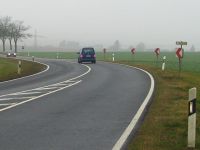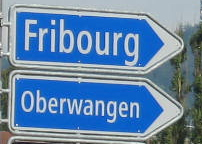Tag:highway=primary
| Description |
|---|
| A highway linking large towns. |
| Rendering in OSM Carto |

|
| Group: highways |
| Used on these elements |
| Useful combination |
| Status: de facto |
| Tools for this tag |
|
Use highway=primary to tag a major highway linking large towns, but which does not satisfy the performance requirements of a highway=motorway and does not qualify to be highway=trunk. Primary highways are generally well matched by the country road classification bylaws and assigned a ref=reference name.
In cities highway=primary is usually used to tag major arterial roads.
See Highway:International equivalence for an overview of highway tagging principles among countries.
How to map
Select all ways which belong to the highway and tag them with highway=primary.
Tags to use in combination
- name=Name of the highway
- ref=reference name for example, A 1
- old_ref=* - former number
- int_ref=* International reference number E.g. E 12
- lanes=* - Number of lanes
- maxspeed=Number indicates the maximum speed which is allowed
- minspeed=Number indicates the minimum speed which needs to be reached to use the highway
- oneway=yes - One-way street
- surface=* - Road surface
- lit=yes - Indicates whether a road is lit
- motorroad=yes - highway that have motorway-like traffic rules
Special situations
When a highway segment runs over a bridge or through a tunnel, split the way from the rest of the road and tag it with one of:
- bridge=yes - if it goes over a street or waterway
- tunnel=yes - if it goes below a street or waterway
Roads with dual carriageways are mapped with two parallel sets of ways tagged oneway=yes, one for each traffic direction. Specify the number of traffic lanes for each direction with the lanes=* tag. Add dual_carriageway=yes for this part of the road.
Route relations
In OSM, roads are divided into many segments (ways) which differ by tag values such as maxspeed=*, bridge=* or tunnel=*. Those segments should be added to a route relation that identifies them as a single legally defined route with common properties (typically ref=*, operator=*, name=*, from=*, to=*).
Road quality
Primary highways in developed countries are normally asphalt roads with two or more lanes. The traffic for both directions is usually not separated by a central barrier. In less developed countries road quality may be far worse and may even include unpaved roads.
Who can use it
Primary highways are usually open to all motorised trafic, while non-motorised traffic may be subject to restrictions subject to local laws. See access=* for applicable limitations.
Official classification

Official classification often matches the actual road importance, and therefore highway=primary should be applied to roads designated as "primary", "1st order" or similar. However, it should not be followed blindly, since some route designations are aspirational. For example, a road leading only to a closed border crossing or toward a future bridge may be classified high in the official national network, but currently has no important role. Such roads should be assigned a lower importance, such as highway=tertiary or highway=unclassified.
Note that OSM maps world as it exists now, while official road classification may be structured in some way for budgeting and symbolic reasons - for example unpaved dirt road may be classified highly as large road is planned there and it qualifies for government funding to construct it. That does not mean that we should map this dirt road as highway=primary just because it is highly classed, maybe actual main connection currently goes elsewhere. Some roads may be highly classified for political or symbolic reasons without actually having such importance.
On the other hand, some of major traffic arteries and boulevards within cities should be tagged as highway=primary or highway=secondary, as appropriate, even if they do not have an official route designation by the country authorities. That may happen, for example, if the country road administration does not have jurisdiction over the city highways.
International equivalence
| Country | Description | more |
|---|---|---|
| Provincial Highway / Urban arterial road (省道或城市主干路) | ||
| 2nd-tier National Roads | WikiProject Greece § Road Network | |
| Strada Statale (SS) or Strada Regionale (SR) | The "SSs" are mostly primary. You should also indicate the name of the highway, if it has one, example:
"SRs" can be tagged as primary as well, if they have a relevant role in linking two major cities. In general the "highway=" tag is not representing the administrative class but the importance of the connection. By default this kind of highway is rendered:
| |
| State Highways and strategic local roads | All State Highways which do not meet the criteria for highway=trunk. Generally two lanes undivided with limited passing lanes and occasionally one-lane bridges.
Strategic local roads are generally the most important roads that are not State Highways. They may be multi-lane divided, or connect major airports, seaports or isolated areas of a city. Examples include South Eastern Highway and Manuaku Road in Auckland, Wairere Drive in Hamilton, and the "Four Avenues" in Christchurch. | |
| National Roads (with ref=EN *) and important urban avenues with two lanes in each direction. | National Roads which are not officially declassified. If it's a declassified EN, it may remain a primary if it is of first order (ex: EN 109). In urban centres, important avenues and arteries with two lanes on each way and a physical separator are also primary. | |
| Hauptstrasse | There are two kind of "Hauptstrassen" in Switzerland:
In contrast to other routes, for example cycling or hiking routes, we do not use relations to model numbered "Hauptstrassen" in Switzerland, use ref=number as described above. | |
| Primary highway or arterial road. | U.S. Highways are mostly primary.
Some State Roads are also primary, the criterion being either connecting large towns/cities, or being a major road in an urban area. By default this kind of highway is rendered:
| |
| Via arterial urbana (urban arterial way), estrada estadual (state road), >50-60 km/h | ||
| Other national roads that is used as a city/ arterial road rather than an intercity road, or a connector, if it only feeds secondary/tertiary roads. Provincial roads linking municipalities with a major highway. Roads linking a city/municipal center (poblacion) with a major national highway. | National roads usually fall as trunk highways, as they carry most intercity traffic, but some national roads should be tagged primary if they are usually roads serving local traffic in a city/rural area or a connector between two trunk highways, when it feeds roads tagged as secondary or tertiary. | |
| Mainly "N-ways" below 400, often called a "provincial way" | See NL:The_Netherlands_roads_tagging | |
| Regional roads network that connect the most important cities and towns of each State. | ||
| National Secondary Roads that connect towns to each other. Has a number between 51 and 99 with an N prefix. | Example: N52 |
| ||||||||||||||||||||||||||||||


